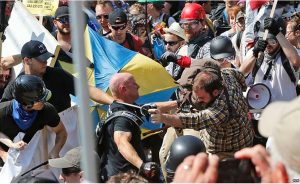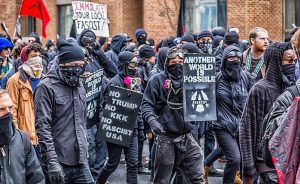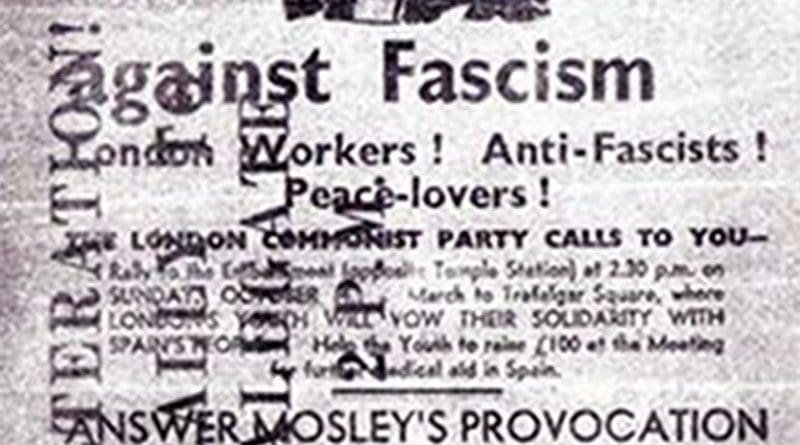Charlottesville And Cable Street: The Essential Difference – OpEd
Modern fascism emerged in Italy during the first world war. Waging war had required the establishment of an all-powerful state able to mobilize the whole nation. After the war fear of left-wing agitation, fostered in part by the Russian Revolution of 1917, led to widespread approval of the authoritarian rule that had arisen in Italy. As a result a fascist party under the dictatorship of Benito Mussolini eventually took control of the nation.
Italian fascists believed, among a host of other things, that liberal democracy had become obsolete, that individual rights should be subordinated to the needs of the state, and that society should be purged of supposedly inferior elements.
These ideas, prevalent also in the thuggish Nazi party then fighting to establish itself in Germany, found their echo in the United Kingdom. Oswald Mosley, a scion of a minor aristocratic family, became a member of parliament when only 22. Having joined and then left both main political parties one after another, he founded his own party which veered increasingly towards the extreme right. Then a visit to Mussolini in 1931 led him to create the British Union of Fascists.
Faced with violent anti-fascist disruptions to his meetings, Mosley established a corps of black-uniformed paramilitary stewards, nicknamed Blackshirts. With his use of the Nazi salute, a flag highly reminiscent of the swastika, and a misplaced nationalism backed by rabid anti-Semitic propaganda, Mosley clearly saw himself on a par with Hitler, as the potential dictator of a fascist Britain.
“I openly and publicly challenge the Jewish interests of this country,” he declared in April 1935, “commanding commerce, commanding the Press, commanding the cinema. dominating the City of London.”
Mosley and his blackshirts were about to provoke the iconic anti-fascist protest of the modern age – a protest that historian Mark Bray describes in his just-published “Antifa: The Anti-Fascist Handbook” as a potent symbol of how to stop fascism, an incident central to the anti-fascist mythology, a kind of North Star in the fight against fascism and white supremacy.
In late September 1936, posters appeared across London declaring: “Mosley speaks in East London. Four great meetings. Four marching columns.”
He was threatening to march thousands of blackshirts right through the streets of East London’s large Jewish district, known as Whitechapel. This was interpreted by Jews and workers alike as a challenge to battle. The British communist party equipped its cohorts with banners and placards reading “Mosley Shall Not Pass!”
On Sunday, October 4, when the police tried to clear a route for the blackshirts through Cable Street, they met determined resistance. Vast numbers of East Enders, including Irish dockers and railway workers, came to help Jews build barricades. In the ensuing encounter the anti-fascists completely outnumbered blackshirts and police combined. The police retreated and ordered Mosley to leave. Resolute defiance had won a famous victory. The Battle of Cable Street went down in history as a prime example of how the forces of intolerance could be overcome by ordinary people acting together in a good cause.

Exactly, it has been claimed, what happened in Charlottesville, Virginia, on August 11 and 12, 2017.
Nominally the rally on Saturday, August 12 was organized in opposition to a plan by local officials to remove a statue of Robert E Lee, the Confederacy’s top general, from Emancipation Park in Charlottesville. This seemed to be one in a series of such protests mounted in other Southern cities against taking down Confederate monuments, but the forces behind this rally ran much deeper. Right-wing extremism, including white nationalism and white supremacy, had been on the rise for some time. The Robert E Lee statue was to prove a flashpoint.
Tensions had begun increasing on the evening of Friday, August 11, when a group of white nationalists marched through the University of Virginia’s campus chanting Nazi and white supremacist slogans, including “White lives matter”; “you will not replace us”; and “Jews will not replace us.” The phrase “you will not replace us” has been reported by the Anti-Defamation League to “reflect the white supremacist world view that… the white race is doomed to extinction by an alleged ‘rising tide of color’ purportedly controlled and manipulated by Jews.”
So, just as in Cable Street, we have a group of extreme right-wing fascists shouting anti-Semitic slogans amid a flood of other hate-filled messages, bent on fomenting a violent encounter with those opposed to them. Where the comparison falls down is when we examine the motives of many of those – by no means all – who came to confront them.

The protest was orchestrated by the establishment that calls itself “Antifa”. Not really a structured organization, Antifa consists of loosely affiliated groups that are, by and large, socially leftist, anti-capitalist, even anarchist, but decidedly anti-racist. Many are also violently anti-Semitic. Using anti-Zionism as a convenient cloak, Antifa demands that American Jews who support Israel are banned from public life, and it prohibits Israel-supporting Jews from participating in their events. It advocates the elimination of Israel as a sovereign state, and promotes the anti-Israel BDS (Boycott, Divestment and Sanctions) movement.
As one commentator recently wrote: “from the American Jewish community’s perspective, there ought to be no distinction between its abhorrence and concern over the white supremacists, and its concerns and abhorrence of the radical left.”
Why is Charlottesville different from Cable Street? Because anti-fascists in 2017 America have become enslaved to the fashionable “intersectionality”, which perceives a link between all manifestations of oppression, however diverse. Equal pay for women is related to Black Lives Matter. Left-wing opinion has decreed that Palestinians are quintessential victims. Their villainous oppressors are Israel, which it ridiculously accuses of every sort of monstrous criminality from harvesting the organs of dead Palestinians to apartheid to genocide. The logical outcome? If you oppose racism, homophobia, sexism, then you must oppose Israel, and by extension all those who support Israel, and by a further extension all Israelis, most of whom, by a curious chance, happen to be Jews. You must deny them a voice, ban them from public life, cut them off from academic interchange, boycott or disrupt their artistic performances.
The Cable Street anti-fascists were Jews supported by non-Jewish friends, neighbours and fellow workers, who hated the anti-Semitism of Oswald Mosley and his Nazi-aping bully-boys, and determined to make a stand against them. Antifa, on the other hand, contains within itself an anti-Semitism as prejudiced and as hateful as that mouthed by the fascists it opposes. Therein lies the essential difference.

